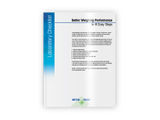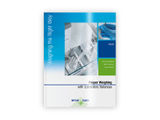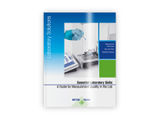To use all functions of this page, please activate cookies in your browser.
my.chemeurope.com
With an accout for my.chemeurope.com you can always see everything at a glance – and you can configure your own website and individual newsletter.
- My watch list
- My saved searches
- My saved topics
- My newsletter
Molybdenum blueMolybdenum blue is a term applied to:
The “heteropoly-molybdenum blues”, are used extensively in analytical chemistry and as catalysts. The formation of “isopoly-molybdenum blues” which are intense blue has been used as a sensitive test for reducing reagents. They have recently been shown to contain very large anionic species based on the so-called "big wheel " containing 154 Mo atoms, with a formula [Mo154O462H14(H2O)70]14−. [1]. Additional recommended knowledge
Heteropoly-molybdenum bluesThe first heteropoly molybdate and first heteropolymetallate, yellow ammonium phosphomolybdate, (NH4)3 PMo12O40 was discovered by Berzelius in 1826.[3]. The phosphorus atom in the anion is termed the hetero-atom, other hetero-atoms are silicon and arsenic. The heteropoly-molybdenum blues have structures based on the keggin structure. The blue colour arises because the near colourless e.g. phosphomolybdate anion, PMo12O403−, can accept more electrons (i.e. be reduced) to form an intensely coloured mixed valence complex. This can occur in one electron or two electron steps[3]. The reduction process is reversible and the structure of the anion is essentially unchanged.[3]
The structure of the anion, PMoV4MoVI8O40 7−, has been determined in the solid state and is a β-isomer i.e. with one of the four groups of edgeshared octahedra on the α-Keggin ion rotated through 60 degrees[4]. Similar structures have been found with silicon, germanium or arsenic hetero-atoms [3]
Uses in quantitative analysisColorimetric determination of P, As, Si and GeThe determination of phosphorus, arsenic, silicon and germanium are examples of the use of heteropoly-molybdenum blue in analytical chemistry. The following example describes the determination of phosphorus. A sample containing the phosphate is mixed with an acid solution of MoVI, for example ammonium molybdate, to produce PMo12O40 3−, which has an α-Keggin structure. This anion is then reduced by, for example, ascorbic acid or SnCl2, to form the blue coloured β-keggin ion, PMo12O40 7− [4] The amount of the blue coloured ion produced is proportional to the amount of phosphate present and the absorption can be measured using a colorimeter to determine the amount of phosphorus. Examples of procedures are:
The comparison of the measured absorption against readings taken for analyses of standard solutions means that a detailed understanding of the structure of the blue complex was unnecessary. Colorimetric determination of glucoseThe Folin-Wu and the Somogyi-Nelson methods are both based on the same principles. In the first step glucose (or a reducing sugar) is oxidised using a solution of Cu(II) ion which in the process is reduced to Cu(I). In the second step the Cu(I) ions are then oxidised back to Cu(II) using a colourless hetero-polymolybdate complex, which is, in the process, reduced to give the characteristic blue colour. Finally the absorption of the hetero-poly molybdenum blue is measured using a colorimeter and compared to standards prepared from reacting sugar solutions of known concentration, to determine the amount of reducing-sugar present. Colorimetric determination of some drugs containing o-hydroquinoneSome drugs that contain an o-hydroquinone group react with phosphomolbydic acid to give the heteropoly-molybdenum blue colour [14]. Micro quantities of the drugs can be determined. Uses in qualitative analysisExamples of simple tests[15] are shown below that rely on the production of the molybdenum blue colour either due to reduction:
or by detection of the heteroatom
Dittmer's spray reagent for phospholipids is used in thin layer chromatography to detect phospholipids. The spray reagent is prepared as follows:
When applied to the TLC plate, compounds containing phosphate ester show up immediately as blue spots[16]. Isopoly molybdenum bluesThe isopoly-molybdenum blues have been known for many years. They are the cause of the “blue waters” found near Idaho Springs, known to Native Americans. They were first documented by Scheele and Berzelius. [1] The compounds responsible for the blue colour were not known until 1995[17]. Before then it was well known that there were polymolybdates of Mo(VI). Molybdenum(VI)oxide, MoO3, when dissolved in aqueous alkali forms the tetrahedral molybdate anion, MoO42−. Dissolving molybdate salts in strong acid produces "molybdic acid", MoO3.2H2O. In between these extremes of pH polymeric ions are produced which are mostly built from MoO6 octahedral units sharing corners and edges. Examples include Mo7O246−, Mo8O264− and Mo36O112(H2O)168− which contain the {(Mo)Mo5}-type unit comprising a central MoO7 pentagonal bipyramid sharing edges with 5 MoO6 octahedra. The later unit occurs also in the giant mixed-valence molybdenum blue species [HxMo368 O1032 (H2O)240 (SO4)48]48− (x≈16) [18] as well as in the cluster described in the next section. The molybdenum blue species are obtained by reduction of acidifed molybdate(VI) solutions.
The big wheelThe first publication of the structure of wheel shaped cluster anion, first determined for the nitrosyl derivative by Muller et al.[17] was announced in New Scientist as "Big Wheel rolls back the molecular frontier"[19]. Further work by the same group then refined the initial findings and determined the structure of the wheel produced in molybdate solutions as [Mo154O462H14(H2O)70]14−.[17] The Mo154 type cluster was then shown to be the basic structural type of molybdenum blue compounds obtained under slightly different conditions.[1]
The spherical vesicleAlong with other aggregates, a hollow, spherical structure self-assembles from approximately 1,165 Mo154 wheels. This was termed a vesicle by analogy with lipid vesicles. Unlike lipid vesicles that are stabilised by hydrophobic interactions it is believed that the vesicle is stabilised by an interplay of van der Waals attraction, long-range electrostatic repulsion with further stabilization arising from hydrogen bonding involving water molecules encapsulated between the wheel-shaped clusters and in the vesicles' interior. The radius of the vesicle is 45 nm. [21] Molybdenum blue pigmentA pigment termed molybdenum blue is recorded in 1844 as a mixture of molybdenum with "oxyde of tin or phosphate of lime".[2] An alternative formulation involves "digesting" molybdenum sulfide with nitric acid to form molybdic acid, which is then mixed with tin filings and a little muriatic acid (HCl)[2]. This is evaporated and heated with alumina. A 1955 paper states that molybdenum blue is unstable and is not used commercially as a pigment.[22] The chemistry of these pigments has not been investigated. References
Categories: Molybdenum compounds | Cluster chemistry | Chemical tests |
|
| This article is licensed under the GNU Free Documentation License. It uses material from the Wikipedia article "Molybdenum_blue". A list of authors is available in Wikipedia. |







